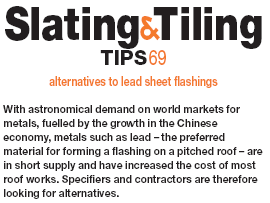 |
 |
 |
 |
 |
 |
 |
|
Check out our web directory of the UK
roofing and cladding industry
www.roofinfo.co.uk |
Sign up for our monthly news letter. |
|
|
|
|

The UK is the main user of lead sheet in
Europe, as most countries consider it a poison. Lead is poisonous when
ingested, so all health and safety recommendations need to be complied
with when working with the material.
Lead has many qualities, the most obvious being
resistance to atmospheric corrosion. It will last for 100 years-plus
provided its installed correctly and is almost maintenance-free.
Installed incorrectly it can fail within five years (which is very
rare).
Lead is easily cut, bent and stretched, but, being
soft, needs to be fully supported, as it is not able to support its own
weight. Lead sheet is heavy, often making it difficult to lift by one
man. This weight is good at resisting wind uplift forces, but, once
lifted, it will bend easily.
Lead expands and contracts more than most metals
and, therefore, unless there are adequate laps and lengths, it will try
and move and, if restricted, result in material failure. Unless coated
with patination oil, it will oxidize and develop a white lead oxide
powder on the surface, which can stain a roof.
Overall, lead has to be treated with respect, needs
skill and time to install correctly, but is versatile. The downside is
that it can be easy to steal. So what are the alternatives?
GRP
Glass reinforced polyester has been used to form preformed lengths of
inclined valley, secret gutter and bonding gutter, which are lighter and
quicker to install than lead. Angled soakers and side abutment flashings
are also available in GRP. Like all resin made products the cost is
relative to the cost of oil. While GRP has a good life expectancy, it is
not as good as lead. However, it is more rigid and therefore, generally,
self-supporting and needs less or, in some instances, no additional
support. It has no scrap value.
Rubber
With the abundance of scrap vehicle tyres and the need to recycle the
material, there is a great potential for this material for forming
flashings. However, the available use of rubber is concentrated into
forming stepped cones to fit around pipes. The rubber is then bonded
onto other materials such as aluminium or lead, as rubber has
insufficient rigidity to resist wind uplift. It has no recycle value at
present.
Aluminium
Aluminium is light and plentiful, but it is also soft and cannot be
stretched as easily as lead. It is also not easy to weld. To make
flashings, long extruded lengths with lapped joints are used, which can
make them more difficult to fit on site. Aluminium is found in many
proprietary products, such as Flashband, a thin aluminium foil with a
sticky bitumen backing. Unfortunately, over time the bitumen leaches out
and becomes detached, making the joint look untidy. Also, the material
is restricted to set widths. Aluminium foil is also used with some ridge
and hip roll flashings in the form of a crimped material that is adhered
to a fleece such that as it stretches, the crimps unfold and allow the
rolled material to follow an undulating surface. Roof windows use
preformed aluminium flashings to form gutters around them. Provided the
aluminium is not part of a composite, it is recyclable. |
 |
Thermoplastics
Thermo plastics such as polyethylene terephthalate and polyacetylene are
available in rolls reinforced with an aluminium expanded metal to allow
the sheet material to be stretched and maintain its new shape.
Thermoplastics soften when hot and become rigid when cold. While easy to
use, they are not self adhesive, so have to be lapped in the same way as
lead. While they are durable, they will not last as long as lead and,
being composite, are not recyclable, and therefore have no scrap value.
Zinc
Zinc was used for many years as a cheap alternative to lead for inclined
valleys. Being relatively brittle and susceptible to environmental
decay, it was not seen as a long-term solution. It is often used as a
coating on other metals, such as steel and aluminium, making them
corrosion resistant. Zinc is recyclable and not poisonous, so seen as
more environmentally friendly than other metals.
Stainless Steel
While stainless steel is expensive, it has been used to form inclined
valleys and other simple cappings. It is very corrosion resistant, long
lasting and recyclable. But, being very rigid, it is impossible to form
into complicated shapes on site.
Conclusion
There is no one material that can perform better, or for longer, than
lead for roof flashings. Other materials can emulate lead in certain
situations, and they need to be understood and used within their
capabilities. Pure materials such as aluminium and zinc can be recycled
provided they are not part of a matrix and are recyclable, but it
makes them vulnerable to vandalism. Products that contain oil-based
materials are subject to the price of oil. Plastics should only be used
where they can demonstrate resistance to ultraviolet light and can be
easily replaced at a later date when they fail, which they will, long
before the tiles or slates.
Tips
- Avoid plastic-based materials in
locations that would be difficult to change at a later date, such as
an inclined valley or a change of pitch in a slate mansard roof.
- Select a flashing material that will
last as long as the roof covering it is being used with.
- Lightweight materials may be easier
to install, but unless they have additional fixings, will be easier
for the wind to rip off.
- In future, all materials will need
to be recyclable; therefore, certain composite materials may become
environmentally unfriendly, regardless of their performance in use.
|
| Compiled
by Chris Thomas, The Tiled Roofing Consultancy, 2 Ridlands Grove,
Limpsfield Chart, Oxted, Surrey, RH8 0ST, tel 01883 724774 |
|